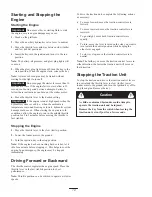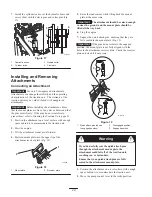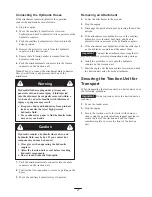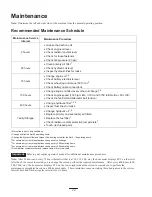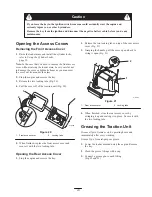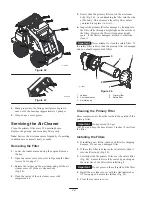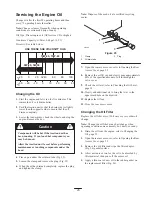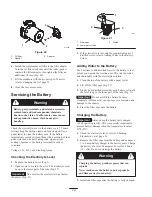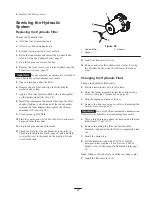
12
Before Operating
Before operating, check the fuel and oil level, remove
debris from the traction unit, and check the tire pressure.
Also, ensure that the area is clear of people and debris.
You should also know and have marked the locations of
all utility lines.
Adding Fuel
Danger
In certain conditions, fuel is flammable and
explosive. A fire or explosion can burn you and
others and can damage property.
•
Fill the fuel tank outdoors, in an open area,
when the engine is cold. Wipe up any fuel that
spills.
•
Do not fill the fuel tank completely full. Add
fuel to the fuel tank until the level is 1/4 to 1/2
in. (6 to 13 mm) below the bottom of the filler
neck. This empty space in the tank allows fuel
to expand.
•
Never smoke when handling fuel, and stay away
from an open flame or where fuel fumes may be
ignited by a spark.
•
Store fuel in an approved container and keep it
out of the reach of children. Never buy more
than a 30-day supply.
The engine runs on clean, fresh diesel fuel with a
minimum cetane rating of 40. Purchase fuel in quantities
that can be used within 30 days to ensure fuel freshness.
Use summer grade diesel fuel (No. 2-D) at temperatures
above 20
°
F (–7
°
C) and winter grade diesel fuel (No. 1-D
or No. 1-D/2-D blend) below 20
°
F (–7
°
C). Use of
winter grade diesel fuel at lower temperatures provides
lower flash point and pour point characteristics, allowing
easier starts and lessening the chances of chemical
separation of the fuel due to lower temperatures.
Use of summer grade diesel fuel above 20
°
F (–7
°
C) will
contribute toward longer life of the fuel pump
components.
Important
Do not use kerosene or gasoline in place of
diesel fuel. Failure to observe this caution will damage
the engine.
1. Park the traction unit on a level surface, lower the
loader arms, and stop the engine.
2. Remove the key and allow the engine to cool.
3. Clean around the fuel tank cap and remove the cap.
4. Use a funnel and add diesel fuel to the fuel tank, until
the level is 1/4 to 1/2 inch (6 mm to 13 mm) below the
bottom of the filler neck.
Note: This space in the tank allows fuel to expand. Do not
fill the fuel tank completely full.
5. Install the fuel tank cap securely. Wipe up any fuel that
may have spilled.
If possible, fill the fuel tank after each use. This will
minimize possible buildup of condensation inside the fuel
tank.
Draining Water from the Fuel
Filter
Drain water or other contaminants from the fuel filter
daily.
1. Stop the engine and remove the key.
2. Open the rear access cover; refer to Opening the Rear
Access Cover, page 23.
3. Turn the drain valve until the water runs out of the
filter (Fig. 6).
Note: The fuel filter is located near the bottom of the fuel
tank.
m–3708
1
2
Figure 6
1.
Fuel filter
2.
Drain valve
4. Close the valve.
5. Close the rear access cover.
Checking the Oil Level
1. Park the traction unit on a level surface, lower the
loader arms, and stop the engine.
2. Remove the key and allow the engine to cool.
3. Open the rear access cover; refer to Opening the Rear
Access Cover, page 23.
4. Clean around the oil dipstick (Fig. 7).
Содержание 22303
Страница 6: ...6 Slope Chart...
Страница 35: ...35...


















